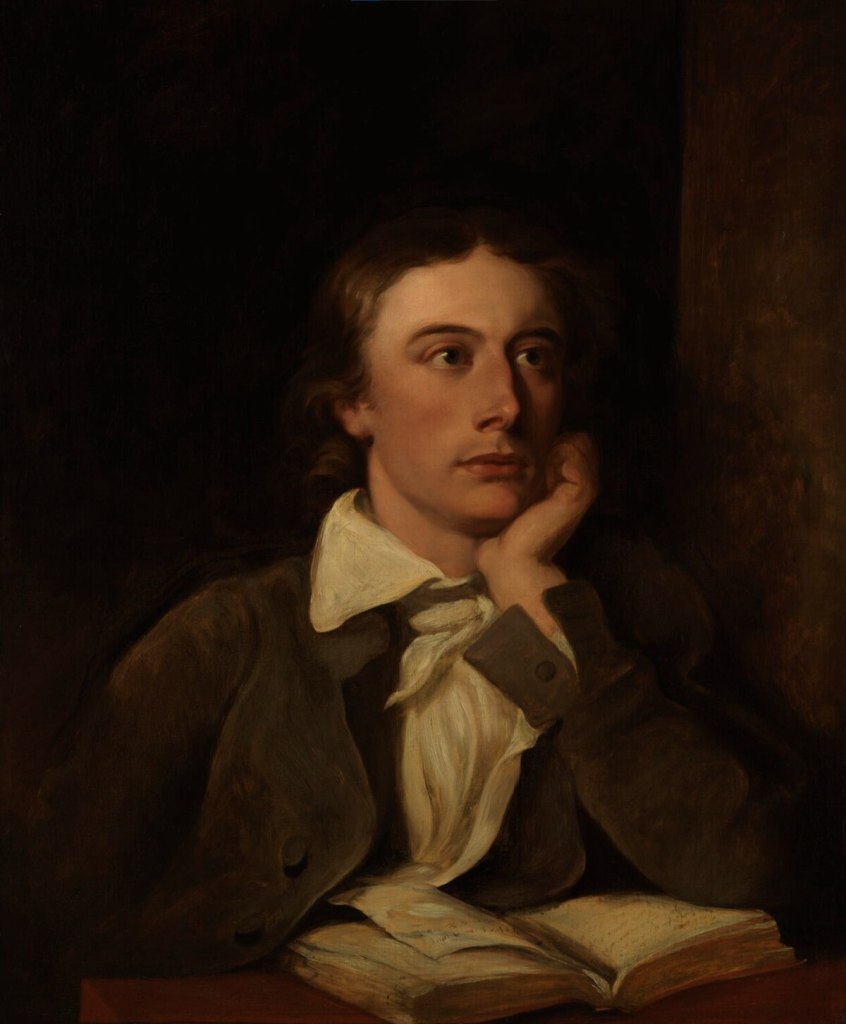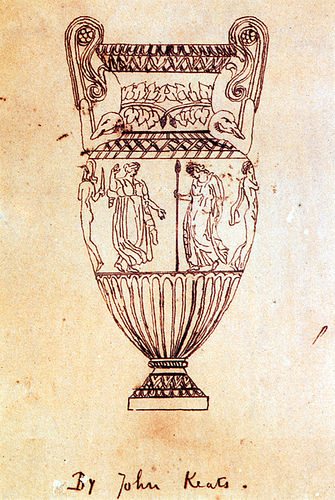Introduction

Figure 1 :Posthumous portrait by William Hilton, c. 1822
John Keats who was a significant figure in the second generation of Romantic poets during his lifetime, Keats faced criticism and negative reviews, Despite that he continued to write prolifically and produced some of his most renowned works in a short span of time he has become one of the most beloved poet (Rizi & Abbasi, 2017). His great odes, including “Ode to a Nightingale” and “Ode on a Grecian Urn,” were written in 1819 and are considered masterpieces of English literature and John Keats viewed human life as an adventurous journey, seeking truth and beauty even through dark times His odes reflect these themes with a unique sensitivity, almost matching that of Shakespeare (Mukherjee, 2021).

Figure 2 :Tracing of an engraving of the Sosibios vase by Keats
Analysis
The first stanza of the poem introduces us to the subject of the poem which is the Grecian urn. The first line “Thou still unravish’d bride of quietness,” here the urn is personified as a bride of quietness this gives the sense of its inability to be fully understood after the death of the artist who created it. The word “unravished” or untouched connects to the next line “Thou foster-child of silence and slow time” As an object made of stone or mud, the urn the passage of time has little effect on its beauty (Wilkes,1986). The silence aspect he speaks of is further extended with the lines “Sylvan historian, who canst thus express /A flowery tale more sweetly than our rhyme”. The concept of “Negative Capability” in John Keats’ poetry which refers to the ability to accept and contemplate uncertainty, mystery, and doubt without seeking definitive answers Keats as the capacity to be in a state of uncertainty without becoming irritable or seeking to impose one’s own understanding or reason on the situation The urn is described as a “sylvan historian” that tells a story through its intricate carvings (Rizi & Abbasi, 2017).The speaker asks a series of questions about the figures on the urn, wondering about what it depicts, but there are no definitive answers. The urn may depict the feelings and events through its imagery this is where the idea of negative capability comes in. This sets up the theme of the poem embracing uncertainty and the unknown.
The second, thirdand fourth stanza diverts away from the urn focusing on the depictions on the urn. The narrators talks to the figure the ‘Fair youth’ ‘Bold Lover’ and ‘trees in springtime’. This scene shows the three aspects of life the natural world, romantic love, and artistic creation (Wilkes, 1986). The paradox is reflected where the speaker celebrates the beauty of these scenes, which is preserved for eternity. The lover cannot leave his song, and the trees and piper cannot change. However, the speaker also notes that these scenes are restricted in some way like “Bold Lover, never, never canst thou kiss”. The tone shifts in the fourth stanza “Will silent be; and not a soul to tell” he talks about the negative aspect of the concept of silence he praises (Wilkes, 1986).which suggest that there may be a change in the way he views the urn.
The last paragraph mainly the massage he is trying to convey “Beauty is truth, truth beauty,—that is all /Ye know on earth, and all ye need to know.” He believes that beauty and truth are intertwined and that the beauty is ultimately the truth and vice versa. This focus on beauty and truth diverges from the more practical and utilitarian goals often associated with traditional revolutionary movements (Mukherjee, 2021). Negative capability in Keats’ “Ode on a Grecian Urn” is a key element in understanding the poem’s themes and Keats’ philosophy of beauty and truth. It highlights the importance of embracing uncertainty and the unknown in the pursuit of artistic expression and the connection with the beauty and truth of the world (Mukherjee, 2021).
Reference
Mukherjee, H. S. (2021). John Keats’s Odes: A Balm to a Tired some Soul: With Reference to Ode to Psyche, Ode on a Grecian Urn, Ode on Melancholy and Ode to Autumn. International Journal of English Literature and Social Sciences, 6(2). https://ijels.com/detail/john-keats-s-odes-a-balm-to-a-tired-some-soul-with-reference-to-ode-to-psyche-ode-on-a-grecian-urn-ode-on-melancholy-and-ode-to-autumn/
Rizi, Hussein S., and Pyeaam Abbasi. “The Encoding / Decoding Model on Keats’s “Ode on a Grecian Urn” as a Thing.” K@ta, vol. 18, no. 2, Dec. 2016, pp. 48-55
Wilkes, J. (1986a). Keats’s Silent Historian: The “Ode on a Grecian Urn.” Sydney Studies in English, 12. https://openjournals.library.sydney.edu.au/SSE/article/view/424

